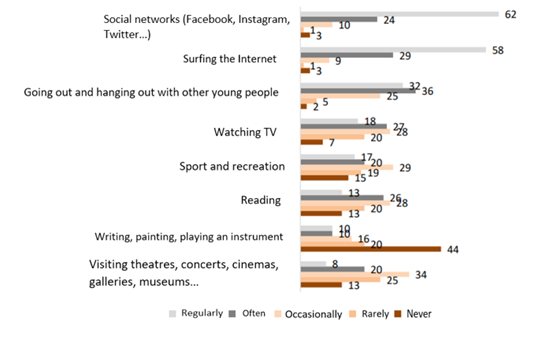8.1 General context
On this page
Main trends in young people's creativity and cultural participation
The Ministry of Youth and Sport has been conducting regular annual Survey on Position and Needs of Youth of the Republic of Serbia since 2008 aiming to analyse the status, challenges, attitudes on social issues that young people share in Serbia in different areas, including culture. The last Survey on Position and Needs of Youth in the Republic of Serbia was carried out in 2019.
Even though some improvement is noticeable in the latest research, findings show that youth do not participate enough in the creation of cultural contents, and that the culture offer for youth is not evenly geographically distributed. Survey on Position and Needs of Youth of the Republic of Serbia from 2016 shows that, viewed from the regional aspect, significant differences exist between Belgrade and Central Serbia in terms of the offer of cultural contents. Unlike previous years, it is noted that a larger number of young people believe that there is enough available content for young people in their environment than those who think that there is not enough content. Until 2019, the prevailing opinion was that there was not enough cultural content for young people - 66% in 2016, 61% in 2017 and 67% in 2018. In 2019 this percentage is 52%. On the other hand, while about a third of respondents in previous research cycles thought that there was enough cultural content, now this share is growing to 58%.

Figure 8.1.1: Is there enough available cultural content for young people in your area?
Comparison of 2016, 2017, 2018 and 2019, in%
Source: Survey on Position and Needs of Youth of the Republic of Serbia, 2019
Young people share the opinion that public space for spending free time of young people exists in their local community (a total of 74%), 18% do not know, and 8% say that such space does not exist in their local environment. Among those who say that there is a space for young people in the local environment, 42% of them believe that there is not enough space, while every third respondent (32%) believes that the existing space is sufficient for their needs.
Serbian youth is not homogenous in terms of cultural consumption and production. Among the biggest obstacles to their participation in cultural activities listed by the respondents, those that stand out are the lack of money and unfavourable geographical circumstances. As indicated in the National Youth Strategy 2015-2025, a study of social background of youth revealed that a very important prerequisite for the involvement of youth in cultural and creative activities was their household income - the higher the income in their household, the greater the degree of their involvement in culture. In addition, young people from more favourable social backgrounds, whose parents are highly educated, youth residing in urban areas, university students and young experts are at the forefront of the cultural scene in Serbia. The Survey on Position and Needs of Youth of the Republic of Serbia from 2019 further reveals that writing, painting and playing an instrument are the least popular activities among Serbian youth as 44% of young people say that they never do it in their free time. Writing, painting and playing an instrument are collectively regularly or often practiced by 20% of respondents, and visits to theatres, cinemas, concerts are collectively practiced regularly or often only by 28% of young people.

Figure 8.1.2: In which of the following ways do you spend your free time and how often do you practice these activities? 2019, in%
Source: Survey on Position and Needs of Youth of the Republic of Serbia, 2019
The most common form of spending free time is surfing the Internet, on social networks, and going out and hanging out with other young people. Thus, a total of 86% of young people spend time on social networks (Facebook, Twitter, Instagram) regularly or often (of which 62% regularly); a total of 87% surf the internet regularly or frequently, and 68% of them regularly or frequently go out and socialize. 18% of young people watch television regularly and another 27% do that often. 13% of young people read regularly, and another 26% say they read often.
Besides this, a research by the Centre for Studies in Cultural Development (CSCD) have addressed the cultural needs of young people. Namely, the largest number of high school students in the Republic of Serbia read only recommended school reading books, very rarely go to theatres, museums, galleries and similar. Although almost half (49.5%) of young people (15‒29 years) point out that there are three to five hours of free time during the day, only 9.3% visiting cultural facilities ranks among the three favourite activities to complete it.
Main concepts
The Culture Development Strategy 2020 -2029 defines contemporary art as artistic and cultural creativity in the fields of literature and publishing, music, fine arts, applied arts, visual arts, design and architecture, theatre, film art and other audio-visual creations, art dances (classical ballet, folk dances, contemporary dances), digital creation and multimedia, and other forms of performing cultural programmes and content (musical, pantomime, circus, street art, etc.).

